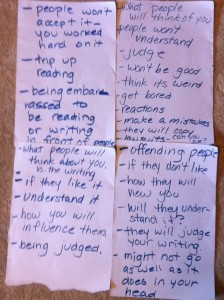Gone Fishing – A Novel for Second Graders
June 13, 2015 | Posted in Blog: Story Stories, Book Reviews, Libraries, libraries, teaching, writing | By Kristin
Comments Off on Gone Fishing – A Novel for Second Graders
Gone Fishing is a treasure for many reasons. First of all: kids love it. It has just enough mischief and naughtiness to spice up a read-a-loud and keep any reluctant reader turning pages. The sibling rivalry at the center of this story will hit home with anyone who has, well, had a sibling. Even for those of us who don’t normally fish, the slimy details keep us involved and invested because we identify with Sam and rejoice as he overcomes his frustrations and failures.
The second reason this book is such a treat you may not even notice up front: it’s a novel-in-verse. And what’s even better is that the audience is second and third grade, where we have a dearth of novels-in-verse. Gone Fishing is perfect for this age group because the subject matter is on-point emotionally: a younger sister horns in on her big brother’s fishing trip with dad. Even more appealing to teachers: the poetry is meticulous. After you’ve been through the book once to catch the plot, you will enjoy re-reading to enjoy Wissinger’s craft. Here, the various poetic forms reveal the emotions as true and entertaining, without being overwrought. And, each form is outlined in a neat appendix, handy for future – and practicing – poets.
Gone Fishing is a natural fit for the second grade English Language Arts Standards in Reading Literature. The story is told from two very different points of view – both Sam and Lucy – making this a perfect read to “speak in a different voice for each character when reading dialogue aloud (CCSS ELA Literacy 2.6).” This short book will help round out the range of complexity called for in the Standards (CCSS ELA Literacy 2.10) by introducing a wide variety of poetry.
Some students may be lucky enough to try writing some of their own poetry using the examples in the back of this book. Turning our complaints, failures and frustrations into entertaining poems can take a lot of the sting out of the curves we all get thrown every now and again. Kudos to Wissinger for setting this shining example of resiliency.
- Title Gone Fishing
- Author Tamera Will Wissinger
- Illustrator Matthew Cordell
- Copyright 2013
- ISBN 9780547820118
- Dewey Decimal Number Fic
- Reading Range 1-3 (2.6)
Bronco Riding
September 9, 2013 | Posted in Blog: Story Stories, Book Reviews, libraries | By Kristin
I’m subbing in a high school library for a few weeks. Before I started this job, when I mentioned it to parents, they would ask me, “Do high school kids even read?”
That question, naturally, made me a bit defensive entering this library. I’m writing YA, ferchrist’s sake. They better read.
Once I arrived at this library I did, indeed, discover that what the teenagers check out most is: computers. But that’s OK. They’re doing their homework.
But hey, I’ve only got a few weeks at this substitute librarian thing. I want to succeed at my future dream career as a YA writer/real librarian. I need these kids to read. So I did the best thing I could think of: what motivates each and every teen to read.
I put together a book display.
At least I picked a subject they might like: Uncommon Couples. That will motivate them to read. Right? Aside from the obvious chick lit, werewolf and vampire stuff, I included Marley & Me, Dr. Jekyll and Mr. Hyde, The Double Helix, that sort of thing.
Then I hid behind the circulation desk and watched to see if any of them picked up a book.
I didn’t witness it, but later in the day, I saw Anatomy of a Boyfriend, by Daria Snydowsky, on the coffee table next to someone’s knitting.
Sweet victory.
But she didn’t check the book out.
Partial victory.
From my spot behind the circulation desk, I saw another girl reading the same book the next period. But she, too, left the library without stopping at the circulation desk.
I wasn’t sure whether this counted as a win for me and books or not.
Then, during lunch, a co-ed group of teenagers had gathered around the coffee table. They were taking turns reading aloud to each other. Boisterous laughter ensued. This is a librarian’s dream, right? A library full of teens, sitting together, warmly conversing, laughing, sharing literature aloud, during their free time.
It is a substitute librarian’s nightmare.
What the hell book was that? It was not The Double Helix.
They were reading Daria Snadowsky’s Anatomy of a Boyfriend. That book was really getting around. Nancy (not her real name), the other librarian, and I quickly looked up reviews for the novel, which I had added to the display without reading.
Rookie librarian.
“Oh, poop,” I said – not exactly what I said – as both of our screens filled with impassioned accounts of the book. I explained to Nancy how I innocently did a subject search for “dating” and found this cute cover. Then I naively stuck the book next to Anthony and Cleopatra, which no one had yet cracked.
Once lunch was over, Nancy retrieved the book from the coffee table. She opened it to a page – 151 – and read this aloud, “You’ve got a long night of bronco riding ahead of you, cowgirl.”
I frowned. “I’ve really enjoyed working with you, Nancy. I hope you like the new sub tomorrow.”
Needless to say, I took the book home and read it myself. You can see my GoodReads review here: link to review
I liked the book, so I put it back in the display. It faced a different direction, so I hate to say this, but it hasn’t been picked up since. However, I am pleased to report that some romance manga, Franny and Zooey, and Gone with the Wind have all been checked out.
And, I’m sure that Anatomy of a Boyfriend is available on any e-reader. You can check those out, as the kids know, at the library. Hey, maybe that’s why they’re checking out so many computers.
Cookies Conquer Fear
June 20, 2013 | Posted in Blog: Story Stories, teaching | By Kristin
Comments Off on Cookies Conquer Fear
As a Young Inklings and Hillview Author Author teacher, I have hosted thirty-one class parties over the last three years. I’ve heard nearly three hundred kids – Kindergarten through age fourteen – read their original stories out loud to an audience.
Each student created something unique, from her own imagination. This story – brand new to the world but very close to her heart – she shared with others, some of whom she did not know.
This takes incredible courage. For boys and girls alike.
I usually ask the teenagers to list their fears the week before the reading. This takes a lot of paper. Fears about reading original work aloud include: “people won’t understand you, tripping up reading, being judged, being misunderstood, tripping up and other variations on what others may think.”
We discuss each of the fears. Unfortunately, these are rational fears. I never promise kids that these things will not happen. They might.
We can’t control what others think. We make mistakes.
I don’t tell students this, but I’ve seen worse things happen: accidents, tears or uncontrolled giggles. It’s scary to face your greatest fears while everyone is watching you.
So, why do it?
Well, the kids in my elementary classes will tell you its because they get a cookie afterward. At each party every kid gets a cookie. They know this from day one. Each student reads the story she has written aloud to an audience of other students and, if elementary kids, also parents – usually about 15 – 30 people. We talk a lot about this cookie for the nine weeks leading up to the party.
When we have writer’s block because we can’t come up with the exactly perfect thing to write, we talk about the cookie, and how many weeks it is until cookies. This might be a good time to go ahead write anything: it doesn’t have to be perfect. It just has to be ready for when we have cookies together.
When we start to get scared about reading the story we have written out loud, we talk about how there will be cookies afterwards. No one will be thinking about us and whether our pants are zipped up, they will be thinking about when we have cookies together.
To be clear: these cookies are from Safeway.
Even though it’s all about the cookies, it’s not about the cookies at all.
It’s about the other part of the sentence: We will all have the cookies together.
It’s about faith. We need to know that all our effort, all our work will be valued by those around us. We need to know we matter. We need to be acknowledged. We will not be alone in the moment of our greatest vulnerability.
Promising friends and families cookies for that support seems like the least we can do. And, certainly, when kids are this courageous, they must know they we will be there for them at the end. When they face their fears – and they are substantial: rejection, judgment, and failure – we will be there.
And, we want to know everything will be OK on the other side.
The cookie is just our excuse.
And that’s just fine with me. These kids are brave enough as it is.

